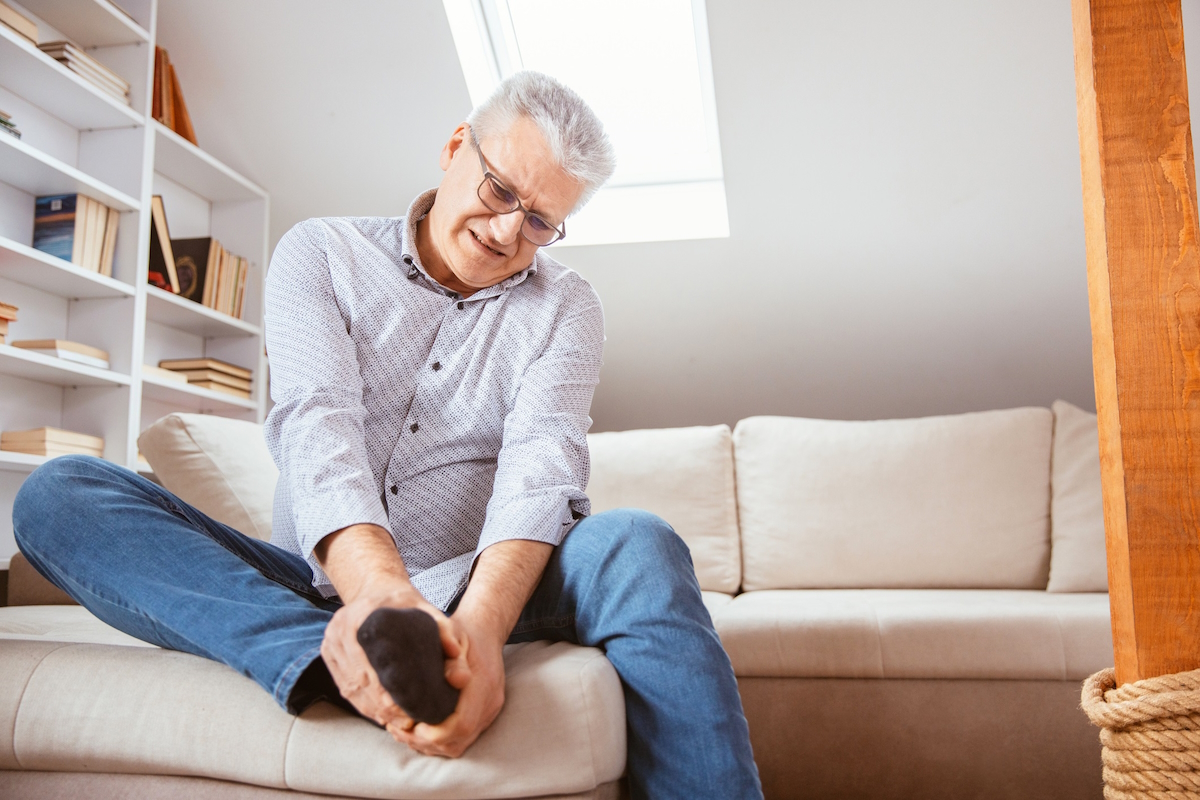Understanding Chronic Foot Pain: Top 11 Causes and How To Find Relief
Author: StrideCare Internal Team

6 Min Read
When Greg* began experiencing chronic foot pain three years ago, his first reaction was to ignore it. Minor injuries and bodily pain he had in the past always seemed to improve with time and rest. Therefore, he believed his newer symptoms, including constant aching, shooting pains, numbness, and burning in his feet, would not be different. The problem was that his condition turned out to be more persistent than usual. Home treatments were not working, leading to a situation where he was struggling to perform everyday activities and even move around the house with ease.
The good news is that finding long-lasting relief for various chronic foot pain symptoms is possible for people like Greg—provided they are open to doing something about it. A study by the American Podiatric Medical Association (APMA) stated that 77% of Americans say they have experienced some level of foot pain in their daily lives. That said, only a third are diligent about protecting their feet and seeking care. With September as Pain Awareness Month, our podiatrists want to show you how easy foot health can be, whether through enlisting help from an expert or taking matters into your own hands with small but necessary lifestyle changes.

 According to the ACPA, there are several things you can do to promote Pain Awareness Month:
According to the ACPA, there are several things you can do to promote Pain Awareness Month:


Are You Experiencing These Symptoms of Chronic Foot Pain?
- Intense stabbing or shooting pain
- Dull, aching pain along the arch or side of the foot
- Burning, throbbing, and tingling sensations
- Cramping
- Sprains and strains
- Persistent inflammation
- Calluses
- Increased foot pain during activity
- Intense heel pain
- Irritated toes and feet
- Chronic wounds
Are you feeling ongoing foot pain? Request an appointment with a StrideCare podiatrist today. Our collaborative approach ensures you receive the care you need.
What Is Pain Awareness Month?
Pain Awareness Month is observed every September. It was started in 2001 by the American Chronic Pain Association (ACPA) to bring various healthcare professionals, policymakers, the public, and the media together to raise awareness and spark helpful dialogue about what chronic pain is, show that it must be treated as a serious public health issue, and create more support and pain management options for people searching for the right treatment options they need to overcome their afflictions and lead better lives. Various organizations, including the ACPA and the U.S. Pain Foundation, host events, webinars, and social media campaigns to share personal stories, educational resources, and advocacy efforts to improve access to quality pain management and treatment options. Everyone experiences pain, and one person’s experience with it can be drastically different from the next, depending on where the pain is located, the reason for it, and the duration. Chronic pain is defined as persistent pain that lasts months and even years. According to the Centers for Disease Control and Prevention’s most recent statistics, an estimated 51.6 million people in the United States experience a form of chronic pain. Chronic pain not only affects a person’s daily work and life activities, but it has also been linked to depression, higher suicide risks, and substance use. Chronic pain also results in billions of dollars spent each year in direct medical costs, lost productivity, and disability. According to the ACPA, there are several things you can do to promote Pain Awareness Month:
According to the ACPA, there are several things you can do to promote Pain Awareness Month:
- Promote Pain Awareness Month in your community and among friends and family.
- Talk with your healthcare providers and alert the media to let them know how important this month is.
- Call your local government and community leaders to let them know about Pain Awareness Month and issues of pain and pain management that they should be focused on.
- Take care of yourself and set aside time to rest.
Foot care is essential for people of all ages. If you have any concerns about your foot health, schedule an appointment with StrideCare’s expert podiatric physicians.
11 Causes of Chronic Foot Pain
Chronic foot pain is classified as persistent or recurring pain in the foot that varies in intensity and typically lasts anywhere from three to six months. For many people, it can last longer, directly impact the heel, arch, toes, or the ball of the foot, and interfere with daily activities, mobility, and overall quality of life. Like other body systems, our feet need to be protected and cared for. This is especially true as we age and begin to slow down on many of the activities we used to do with ease. Here are 11 common causes of chronic foot pain:- Plantar fasciitis — A painful inflammation of the thick band of tissue that runs across the bottom of the foot and connects the heel bone to the toes. It is caused by repetitive strain from excessive walking, running, and jumping.
- Flat feet — It is estimated that 20-30% of the U.S. population has flat feet, characterized by the entire sole of the foot being able to touch the floor when standing. You can be born with flat feet or develop them over time because of weight issues, injury or trauma, diabetes, or excessive exercise.
- Rheumatoid arthritis — This autoimmune disease affects over 1.3 million Americans and is characterized by painful inflammation in one or more joints. This includes the feet, where the condition feels like a sprain or broken bone.
- Neuropathy — Nerve damage causes pain, tingling, or numbness in the feet in roughly 20 million people in the United States each year. It is associated with several underlying conditions, including diabetes and arthritis.
- Bunions — These bony bumps at the base of the big toe develop over time and are more common in women and seniors. Typically, they are caused by genetics, ill-fitting shoes, and repeated injuries.
- Bone spurs — Arthritis, Achilles tendonitis, and plantar fasciitis are common conditions leading to bone spurs. If a joint in your foot (for example, your heel) develops these bony growths, it can lead to chronic foot pain.
- Gout — This condition is characterized by sudden, severe pain, swelling, redness, and tenderness in the joints, often located at the base of the big toe. The affected area is typically hot, swollen, and tender to the touch. Gout risks increase due to diabetes, obesity, high blood pressure, and certain medications.
- Hammertoes — If continuous abnormal pressure is placed on the toes (such as wearing shoes that do not fit properly), it can cause an abnormal bend in the toe. If you have hammertoes, you should seek treatment to avoid complications and chronic foot pain.
- Warts — These small growths enter the skin through a cut in the bottom of the foot and can grow on the heels, soles, or any other area of the foot. While they are far from life-threatening and could go away over time without treatment, they tend to be painful and will likely multiply if left untreated.
- Ingrown toenails — This is when a toenail grows past the nail bed and digs into your skin, causing persistent irritation, swelling, and pain. It is usually because of improper toenail trimming and shoes that do not fit correctly, but it can also be because of poor blood circulation in the feet and diabetes.
- Chronic wounds — Wounds on the feet are considered chronic if they do not heal through traditional methods within a few days or weeks and have not completely healed in six weeks. Chronic wounds are typically the result of diabetes or vascular diseases and conditions such as venous insufficiency and swollen legs.

How Can I Find Relief from Chronic Foot Pain?
When foot pain persists or is resistant to standard rest, it is a sign that something else is going on and that you need to schedule an appointment with your podiatrist before your situation becomes too severe. There are many ways to avoid chronic foot pain and reverse chronic pain symptoms. Here are a few:- Wear properly fitted shoes.
- Avoid walking around barefoot.
- Avoid standing on your feet for prolonged periods.
- Exercise and maintain a healthy weight.
- Take frequent breaks to rest your feet if they are sore.
- Resist the temptation to fight through existing injuries before they have healed.
- Inspect your feet daily for cracks, cuts, redness, sores, calluses, warts, etc.
- Keep your toenails trimmed properly.
- Consider using compression socks for added support.
- Consider alternative therapies such as acupuncture and chiropractic care.
- Do not ignore foot pain of any kind, especially chronic foot pain.
- Consult with a specialist in foot care. These doctors are known as podiatrists.
StrideCare Is Here To Help With Your Chronic Foot Pain
We all experience pain, especially in our feet. After all, we rely on our feet for everything. That said, far too many people ignore their sore feet without investigating the root cause or doing something about it from a medical perspective. The next thing they know, they are dealing with a chronic pain situation. Please do not underestimate your foot health—we want to help with your chronic foot pain issues. A consultation with a StrideCare podiatrist can determine the type, severity, and location of your chronic foot pain issues. Our expert doctors and caring staff utilize the latest technologies and treatments to help our patients reclaim their lives. As the largest multi-specialty network in Texas, StrideCare helps patients achieve improved quality of life from common and complex conditions, including diabetic vascular issues, peripheral arterial disease, venous insufficiency, foot neuropathy, varicose veins, diabetic foot ulcers, wounds and more. The good news is that finding an experienced, qualified podiatrist near you is easier than ever, with over 50 StrideCare clinic locations across the state. We are a Texas-based practice, with each clinic locally managed. Please contact us at 866-552-4866 or complete the appointment form to schedule a consultation. At StrideCare, we are here to help, all while providing compassionate patient care.This information is not a substitute for professional medical advice. Prior to starting any new treatment or questions regarding a medical condition, always seek the advice of your doctor or other qualified health provider. StrideCare serves North Texas and South Texas communities, including Houston, Irving, Katy, Kaufman, Mansfield, McKinney, Mesquite, Midland, North Dallas, Odessa, Paris, Pecos, Plano, Prosper, Rockwall, Round Rock, Rowlett, Royce City, San Antonio, Sherman, South Dallas, Southlake, Stone Oak, Sugar Land, Sulphur Springs, The Woodlands, Waxahachie, Webster, Addison, Allen, Anna, Arlington, Austin, Carrollton, Celina, Clear Lake, Craig Ranch, Dallas, Euless, Flower Mound, Forney, Fort Worth, Frisco, Garland and more. *Patient names and/or photos may be changed to protect patient confidentiality.


